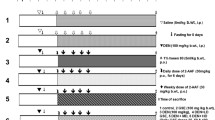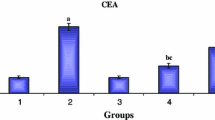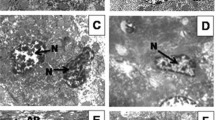Abstract
One of the focuses in current cancer chemoprevention studies is the search for nontoxic chemopreventive agents that inhibit the initiation of malignant transformation. Cancer biomarkers are quantifiable molecules involved in the physiologic or pathologic events occurring between exposure to carcinogens and the development, progression of cancer. Biomarkers may be the consequence of a continuous process, such as increased cell mass, or a discrete event, such as genetic mutation. Analysis of tumor markers can be used as an indicator of tumor response to therapy. Gallic acid is a naturally available polyphenol, possess strong antioxidant activity with a capacity to inhibit the formation of tumors in several cancer models. In the present study, we investigated the antiproliferative effect of gallic acid during diethylnitrosamine (DEN)-induced hepatocellular carcinoma (HCC) in male wistar albino rats. DEN treatment resulted in increased levels of aspartate transaminase, alanine transaminase, alkaline phosphatase, acid phosphatase, lactate dehydrogenase, gamma-glutamyltransferase, 5′-nucleotidase, bilirubin, alpha-fetoprotein, carcinoembryonic antigen, argyophillic nucleolar organizing regions, and proliferating cell nuclear antigen. Gallic acid treatment significantly attenuated these alterations and decreased the levels of AgNORs and PCNA. These finding suggests that gallic acid is a potent antiproliferative agent against DEN-induced HCC.







Similar content being viewed by others
References
Ahmedin Jemal DVM, Rebecca Siegel MPH, Murray T, Xu J, Thun MJ (2007) Cancer statistics. CA Cancer J Clin 57:43–66
El-Serag HB (2004) Hepatocellular carcinoma: recent trends in the United States. Gastroenterology 127:27–34. doi:10.1053/j.gastro.2004.09.013
Paraskevi A, Ronald A (2006) Hepatocellular carcinoma pathogenesis: from genes to environment. Nat Rev Cancer 6:1–14. doi:10.1038/nrc1797
Ramakrishnan G, Balaji Raghavendran HR, Vinodhkumar R, Devaki T (2006) Suppression of N-nitrosodiethylamine induced hepatocarcinogenesis by silymarin in rats. Chem Biol Interact 161:104–114. doi:10.1016/j.cbi.2006.03.007
Bansal AK, Bansal M, Soni G, Bhatnagar D (2005) Protective role of Vitamin E pre-treatment on N-nitrosodiethylamine induced oxidative stress in rat liver. Chem Biol Interact 156:101–111. doi:10.1016/j.cbi.2005.08.001
Bartsch H, Montesano R (1984) Relevance of nitrosoamines to human cancer. Carcinogenesis 5:1381–1393. doi:10.1093/carcin/5.11.1381
Steinmetz KA, Potter JD (1991) Vegetables, fruits and cancer, I. Epidemiology. Cancer Causes Control 2:325–357. doi:10.1007/BF00051672
Kahkonen MP, Hopia AI, Vuorela HJ et al (1999) Antioxidant activity of plant extracts containing phenolic compounds. J Agric Food Chem 47:3954–3962. doi:10.1021/jf990146l
Madlener S, Illmer C, Horvath Z et al (2007) Gallic acid inhibits ribonucleotide reductase and cyclooxygenases in human HL-60 promyelocytic leukemia cells. Cancer Lett 245:156–162. doi:10.1016/j.canlet.2006.01.001
Galati G, O’Brien PJ (2004) Potential toxicity of flavonoids and other dietary phenolics: significance for their chemopreventive and anticancer properties. Free Radic Biol Med 37:287–303. doi:10.1016/j.freeradbiomed.2004.04.034
Salucci M, Stivala LA, Maiani G, Bugianesi R, Vannini V (2002) Flavonoids uptake and their effect on cell cycle of human colon adenocarcinoma cells (Caco2). Br J Cancer 86:1645–1651. doi:10.1038/sj.bjc.6600295
Inoue M, Suzuki R, Koide T, Sakaguchi N, Ogihara Y, Yabu Y (1994) Antioxidant, gallic acid, induces apoptosis in HL- 60RG cells. Biochem Biophys Res Commun 204:898–904. doi:10.1006/bbrc.1994.2544
Kawada M, Ohno Y, Ri Y, Ikoma T, Yuugetu H, Asai T (2001) Anti-tumor effect of gallic acid on LL–2 lung cancer cells transplanted in mice. Anticancer Drug 12:847–852. doi:10.1097/00001813-200111000-00009
Li L, Ng TB, Gao W, Li W, Fu M, Niu SM (2005) Antioxidant activity of gallic acid from rose flowers in senescence accelerated mice. Life Sci 77:230–240. doi:10.1016/j.lfs.2004.12.024
Ramakrishnan G, Augustine TA, Jagan S, Vinodhkumar R, Devaki T (2007) Effect of silymarin on N-nitrosodiethylamine induced hepatocarcinogenesis in rats. Exp Oncol 29(1):39–44
Lowry OH, Rosenbrough NJ, Farr AL, Randall RJ (1951) Protein measurement with the Folin-phenol reagent. J Biol Chem 193:265–275
King J (1965) The transferase-alanine and aspartate transaminase. In: King J (ed) Practical clinical enzymology. D Van Nostrand Company Ltd, London, pp 121–138
King J (1965) The phosphohydrolases-acid and alkaline phosphatase. In: King J (ed) Practical clinical enzymology. D Van Nostrand Company Ltd, London, pp 191–208
King J (1965) The dehydrogenases or oxido reductase-lactate dehydrogenase. In: King J (ed) Practical clinical enzymology. D Van Nostrand Company Ltd, London, pp 83–93
Malloy HT, Evelyn KA (1937) The determination of bilirubin with the photoelectric colorimeter. J Biol Chem 119(112):481–490
Rosalki SB, Rao D (1972) Serum glutamyl transpeptidase activity in alcoholism. Clin Chim Acta 39:41–47. doi:10.1016/0009-8981(72)90297-5
Luly P, Barnabei O, Tria E (1972) Hormonal control in vitro of plasma membrane bound Na+, K+-ATPase of rat liver. Biochim Biophys Acta 282:447–452. doi:10.1016/0005-2736(72)90352-5
Ramakrishnan G, Elinos-Baaez CM, Jagan S et al (2008) Silymarin downregulates COX-2 expression and attenuates hyperlipidemia during NDEA-induced rat hepatocellular carcinoma. Mol Cell Biochem 313(1–2):53–61. doi:10.1007/s11010-008-9741-5
Ploton D, Menager M, Jeannesson P, Himber G, Pigeon F, Adnet JJ (1986) Improvement in the staining and in the visualization of the argyrophilic proteins of the nucleolar organizer regions at the optical level. Histochem J 18:5–14. doi:10.1007/BF01676192
Padmakumaran Nair KG, Deepadevi KV, Arun P et al (1998) Toxic effect of systemic administration of low doses of the plasticizer di-(2-ethylhexyl) phthalate [DEHP] in rats. Indian J Exp Biol 36:264–272
Whittby LG, Perey-Robb IW, Smith AT (1984) Enzymes tests in diagnosis, Lecturer notes in clinical chemistry, 3rd edn. Black Well Scientific Publications, pp 138–169
Lipport M, Papadopoulos N, Javadpour NR (1981) Role of lactate dehydrogenase isoenzymes in testicular cancer. Urology 18:50–53. doi:10.1016/0090-4295(81)90495-7
Kamaraj S, Vinodhkumar R, Anandakumar P, Jagan S, Ramakrishnan G, Devaki T (2007) The effects of quercetin on antioxidant status and tumor markers in the lung and serum of mice treated with benzo(a)pyrene. Biol Pharm Bull 30(12):2268–2273. doi:10.1248/bpb.30.2268
Thangaraju M, Rameshbabu J, Vasavi H, Ilanchezian S, Vinitha R, Sachdanandam P (1998) The salubrious effect of tamoxifen on serum marker enzymes, glycoproteins lysosomal enzyme level in breast cancer women. Mol Cell Biochem 185:85–94. doi:10.1023/A:1006874005764
Doa TL, Ip C, Rater J (1980) Serum sialyl transferase and 5′ nucleotidase as reliable biomarkers in women with breast cancer. J Natl Cancer Inst 65:529
Anjana J, Monika B, Sangeeta S (2007) Protective effect of Terminalia belerica Roxb and gallic acid against carbon tetrachloride induced damage in albino rats. J Ethnopharmacol 109:214–218. doi:10.1016/j.jep.2006.07.033
Harper HA (1961) The functions and tests of the liver. Review of physiological chemistry. Lange Medical Publishers, Los Atlos, CA, pp 271–283
Rajkapoor B, Jayakar B, Murugesh N, Sakthisekaran D (2006) Chemoprevention and cytotoxic effect of Bauhinia variegata against N-nitrosodiethylamine induced liver tumors and human cancer cell lines. J Ethnopharmacol 104:407–409. doi:10.1016/j.jep.2005.08.074
Zimmermann H (1992) 5′-nucleotidase: molecular structure and functional aspects. Biochem J 285:345–365
Sadej R, Spychala J, Skladanowski AC (2006) Expression of ecto-5′-nucleotidase (eN, CD73) in cell lines from various stages of human melanoma. Melanoma Res 16:213–222. doi:10.1097/01.cmr.0000215030.69823.11
Ujházy P, Berleth ES, Pietkiewicz JM et al (1996) Evidence for the involvement of ecto-5′-nucleotidase (CD73) in drug resistance. Int J Cancer 68:493–500. doi:10.1002/(SICI)1097-0215(19961115)68:4<493::AID-IJC15>3.0.CO;2-6
Spychala J (2000) Tumor-promoting functions of adenosine. Pharmacol Ther 87:161–173. doi:10.1016/S0163-7258(00)00053-X
Pellegrina CD, Padovani G, Mainente F et al (2005) Anti-tumor potential of a gallic acid containing phenolic fraction from Oenothera biennis. Cancer Lett 226:17–25. doi:10.1016/j.canlet.2004.11.033
Yao DF, Dong ZZ, Yao DB et al (2004) Abnormal expression of hepatoma-derived gammaglutamyltransferase subtyping and its early alteration for carcinogenesis of hepatocytes. Hepatobiliary Pancreat Dis Int 3:564–570
Tang QY, Yao DF, Lu JX, Wu XH, Meng XY (1999) Expression and alterations of different molecular form gammaglutamyl transferase and total RNA concentration during the carcinogenesis of rat hepatoma. World J Gastroenterol 5:356–358
Sell S, Becker F, Leffert HL et al (1983) α-Fetoprotein as a marker for early events and carcinoma development during chemical hepatocarcinogenesis. Environ Sci Res 29:271–293
Endo Y, Kanai K, Oda T et al (1975) Clinical significance of alpha-fetoprotein in hepatitis and liver cirrhosis. Ann N Y Acad Sci 259:234–238. doi:10.1111/j.1749-6632.1975.tb25418.x
Sirri V, Roussel P, Trerè D, Derenzini M, Hernandez-Verdun D (1995) Amount variability of total and individual Ag-NOR proteins in cells stimulated to proliferate. J Histochem Cytochem 43:887–893
Wu WY, Xu Q, Shi LC, Zhang WB (2000) Inhibitory effects of Curcuma aromatica oil on proliferation of hepatoma in mice. World J Gastroenterol 6:216–219
Lin GY, Chen ZL, Lu CM, Li Y, Ping XJ, Huang R (2000) Immunohistochemical study on p53, H-rasp21, c-erbB–2 protein and PCNA expression in HCC tissues of Han and minority ethnic patients. World J Gastroenterol 6:234–238
Kelman Z (1997) PCNA: structure, functions and interactions. Oncogene 14:629–640. doi:10.1038/sj.onc.1200886
Acknowledgments
The authors wish to thank Prof. Nalini Rajamannan, Northwestern Universitry, USA for the kind gift of antibody, PCNA. One of the authors Gopalakrishnan Ramakrishnan gratefully acknowledges the Indian Council of Medical Research, New Delhi, India for financial assistance in the form of Senior Research Fellowship.
Author information
Authors and Affiliations
Corresponding author
Rights and permissions
About this article
Cite this article
Jagan, S., Ramakrishnan, G., Anandakumar, P. et al. Antiproliferative potential of gallic acid against diethylnitrosamine-induced rat hepatocellular carcinoma. Mol Cell Biochem 319, 51–59 (2008). https://doi.org/10.1007/s11010-008-9876-4
Received:
Accepted:
Published:
Issue Date:
DOI: https://doi.org/10.1007/s11010-008-9876-4




